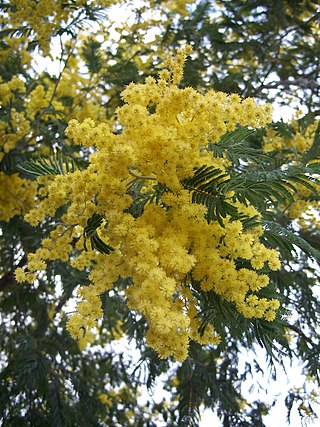
Acacia dealbata, the silver wattle, blue wattle or mimosa, is a species of flowering plant in the legume family Fabaceae, native to southeastern Australia in New South Wales, Victoria, Tasmania, and the Australian Capital Territory, and widely introduced in Mediterranean, warm temperate, and highland tropical landscapes.

Prostanthera lasianthos, commonly known as the Victorian Christmas bush or coranderrk , is a large shrub or small tree of the mint family, Lamiaceae, which is native to Queensland, New South Wales, Victoria and Tasmania in Australia. It grows up to 10 m (35 ft) high but is usually much less and is found in wet sclerophyll forests, often beside creeks. Its flowers, which appear in profuse sprays, are about 2 cm long and white or pale lilac, with purple and orange blotches in the throat. They appear in late spring and summer, and specifically around Christmas time in Victoria. The fragrant, toothed leaves are 4 to 12 cm long and about 1.5 cm wide.

Acacia acanthoclada, commonly known as harrow wattle, is a species of flowering plant in the family Fabaceae and is endemic to southern continental Australia. It is a low, highly branched, spreading and spiny shrub with wedge-shaped to triangular or egg-shaped phyllodes with the narrower end towards the base, and spherical heads of up to 30 flowers, and linear, spirally-coiled pods.

Acacia falcata, commonly known as sickle wattle and by other vernacular names including sally, is a perennial shrub or tree native to eastern Australia, which reaches five metres in height and has cream flowers in early winter. It gets its common and scientific name for its sickle-shaped leaves. Hardy and adaptable to cultivation, it is used in regeneration of bushland.

Acacia longifolia is a species of Acacia native to southeastern Australia, from the extreme southeast of Queensland, eastern New South Wales, eastern and southern Victoria, southeastern South Australia, and Tasmania. Common names for it include long-leaved wattle, acacia trinervis, aroma doble, golden wattle, coast wattle, sallow wattle and Sydney golden wattle. It is not listed as being a threatened species, and is considered invasive in Portugal, New Zealand and South Africa. In the southern region of Western Australia, it has become naturalised and has been classed as a weed by out-competing indigenous species. It is a tree that grows very quickly reaching 7–10 m in five to six years.

Acacia brunioides, commonly known as brown wattle is a species of flowering plant in the family Fabaceae and is endemic to eastern Australia. It is an erect or spreading shrub with more or less cylindrical phyllodes, inflorescenses arranged singly in leaf axils, each with 20 to 27 more or less white to bright yellow flowers, and straight, papery to leathery pods up to 15–60 mm (0.59–2.36 in) long.
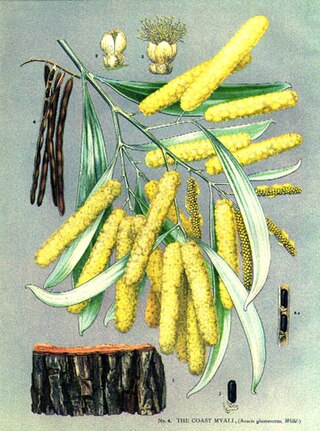
Acacia binervia, commonly known as the coast myall, is a wattle native to New South Wales and Victoria. It can grow as a shrub or as a tree reaching 16 m in height. This plant is reportedly toxic to livestock as the foliage (phyllodes) contain a glucoside which can produce hydrogen cyanide if cut.

Acacia verticillata is a perennial shrub to small tree native to south eastern Australia.
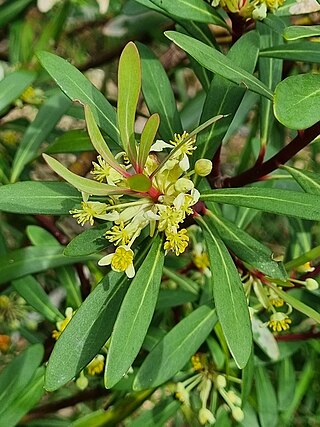
Tasmannia xerophila, commonly known as alpine pepperbush, is a species of flowering plant in the family Winteraceae and is endemic to south-eastern continental Australia. It is a bushy shrub to small tree with lance-shaped leaves, the narrower end towards the base. Male and female flowers are borne on separate plants, the male flowers with 9 to 30 stamens and the female flowers with up to 8 carpels. The fruit is glossy black and contains 2 to 7 seeds.

Olearia phlogopappa commonly known as the dusty daisy-bush or alpine daisy-bush is a species of flowering plant in the family Asteraceae that is commonly found in eastern New South Wales, Victoria and Tasmania. It is a small shrub with greyish-green foliage, daisy-like flowers in white, pink or mauve that can be seen from spring to late summer.

Acacia suaveolens is a shrub species endemic to Australia. It grows to between 0.3 and 3.5 metres high and has smooth purplish-brown or light green bark and has straight or slightly curving blue-green phyllodes The pale yellow to near white globular flower heads generally appear between April and September in its native range. These are followed by flattened, bluish oblong pods which are up to 2 to 5 cm long and 8 to 19 mm wide.
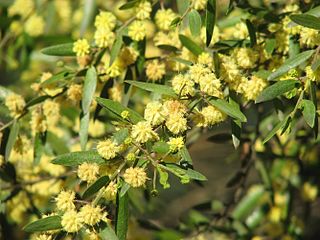
Acacia verniciflua, commonly known as varnish wattle, is a shrub or small tree species that is endemic to Australia. The species occurs in dry sclerophyll forest in South Australia, Victoria, New South Wales and Queensland. It is often found growing alongside Eucalyptus obliqua where it can dominate the understory.

Acacia buxifolia, commonly known as box-leaf wattle, is shrub species that is endemic to eastern Australia.

Acacia aspera, commonly known as rough wattle, is a spreading shrub which is endemic to south-eastern Australia. It grows to up to 2 metres high and has phyllodes which are 10 to 30 mm long and 2 –4 mm wide. The pale yellow to gold globular flowerheads appear singly or in groups of two in the axils of the phyllodes in July to September, followed by curved or coiled seed pods which are 20 to 70 mm long and 3 to 5 mm wide.

Acacia rigens, commonly known as nealie, is an erect or spreading shrub or small tree that is endemic to Australia. Other common names include needle wattle, needlebush acacia, nealia and nilyah.

Acacia cognata, commonly known as bower wattle, river wattle or narrow-leaved bower wattle, is a tree or shrub species that is endemic to south eastern Australia.

Pimelea ligustrina is a species of flowering plant in the family Thymelaeaceae, and is endemic to south-eastern Australia. It is a shrub with lance-shaped or narrowly elliptic leaves arranged in opposite pairs, and clusters of creamy-white, white or pinkish flowers usually surrounded by 4 or 8, greenish to reddish brown involucral bracts.
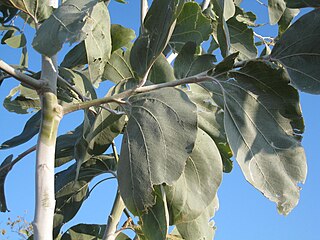
Acacia dunnii, commonly known as elephant ear wattle or Dunn's wattle, is a shrub or tree of the genus Acacia and the subgenus Plurinerves.

Acacia aculeatissima, commonly known as thin-leaf wattle or snake wattle, is a species of flowering plant in the family Fabaceae and is endemic to south-eastern continental Australia. It is usually a prostrate shrub with sharply pointed, needle-shaped phyllodes, flowers arranged in up to 3 more or less spherical heads of 15 to 25 flowers, and linear, papery pods up to 60 mm (2.4 in) long.

Acacia ulicifolia, commonly known as prickly Moses or juniper wattle is a shrub of the genus Acacia and the subgenus Phyllodineae, native to Australia.





















